Following our analysis of NK Rijeka and Osijek, we now move our attention to Igor Tudor’s Hajduk Split – one of the biggest teams in 1. HNL and a squad that is still fighting for the second spot in the table behind Dinamo Zagreb, Croatia’s only consistent Champions League contestant.
This article will dissect Tudor’s philosophy and tactics at Hajduk Split and will be divided into both data analysis and tactical analysis to get a clear overview of the club.
Data analysis
Before delving into the tactics, we have to go through the purely statistical part that will help us determine some general trends of the team, their overall style in both attack and defence, and also identify key figures in all phases of play.
As was the case with all of our previous 1. HNL pieces, we’ll start with determining the team’s style of play by measuring the number of lateral passes they make against the long balls per 90 minutes.
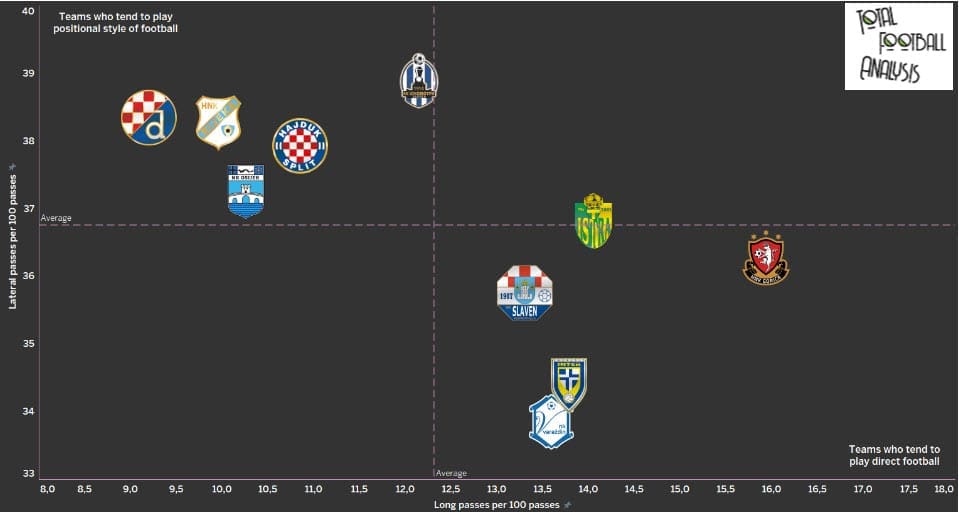
While this is only a general overview, those two metrics can still help us divide the teams by positional and direct styles of play, and Hajduk are among the teams who clearly prefer the former approach.
But it has to be said that among the top four positional teams from the graph, the team from Split deploy the most long balls per 90 minutes, suggesting that despite mostly having a positional approach, they are not complete strangers to a more direct approach when necessary.
Next, we will try and determine their defensive style of play by measuring their PPDA values (passes allowed per defensive action). Quite clearly, alongside their eternal rivals Dinamo Zagreb, Hajduk are the most aggressive team in the league and have a good defensive setup that aims to win the ball quickly after losing possession and forces the opposition to shoot from distance.
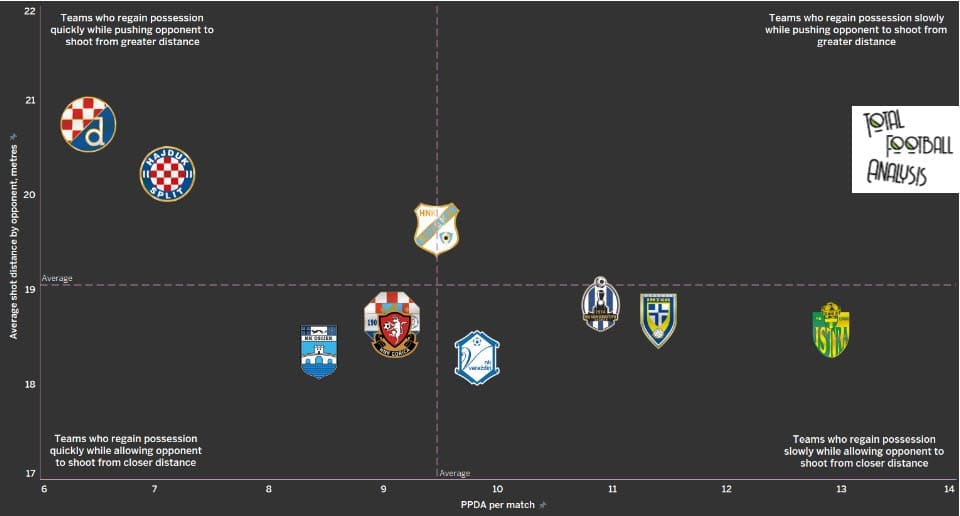
So far, 30% of their conceded goals have come from long shots (9), 17% from counter-attacks (5), 10% after set-pieces (3) and 13% from direct free-kicks and penalties (4). It’s also important to note they concede the most chances in the last 15 minutes of both halves, with 19 goals in total from 30-45 (10 goals) and 75-90 (9 goals).
With 10.83 shots against per 90 minutes so far in 19/20, they are the fourth-best team in that regard and make the fourth-most recoveries with 80.75 per 90, 13% of them happening in the final third and only Dinamo and Osijek having more with 16% and 15% respectively.
With team stats out of the way, we can take a look at Hajduk Split’s players, starting with the age profile of the squad which will help us identify their key figures in 2019/20 and their respective age group.
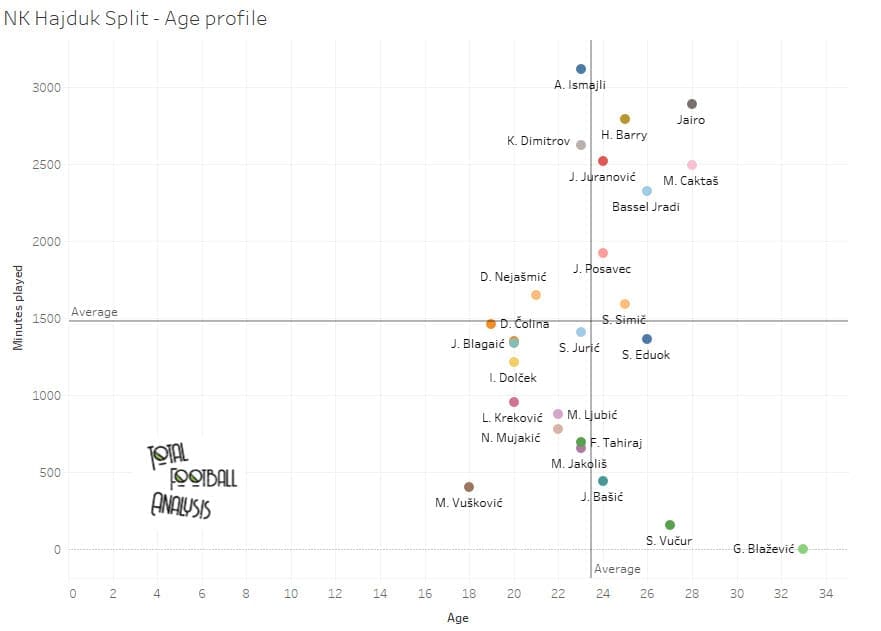
The most positive thing about their age matrix is that they have a young squad in which no players over 30 have a big role in the team. Similarly, players like Ardijan Ismajli (23), Kristian Dimitrov (23), and Josip Juranović (24) are young and important while the likes of Jairo (28), Mijo Caktaš (28), and Bassel Jradi (26) are in their prime years.
Hamza Barry (25) is also among their best and most important players but is likely to leave the squad at the end of the season with his contract set to expire in the summer. Darko Nejašmić (21) and Josip Posavec (24) should see an increase in game time as time goes on.
Next, we’ll take a look at the best defenders in the squad by measuring their defensive duels won in % and defensive duels per 90 minutes.
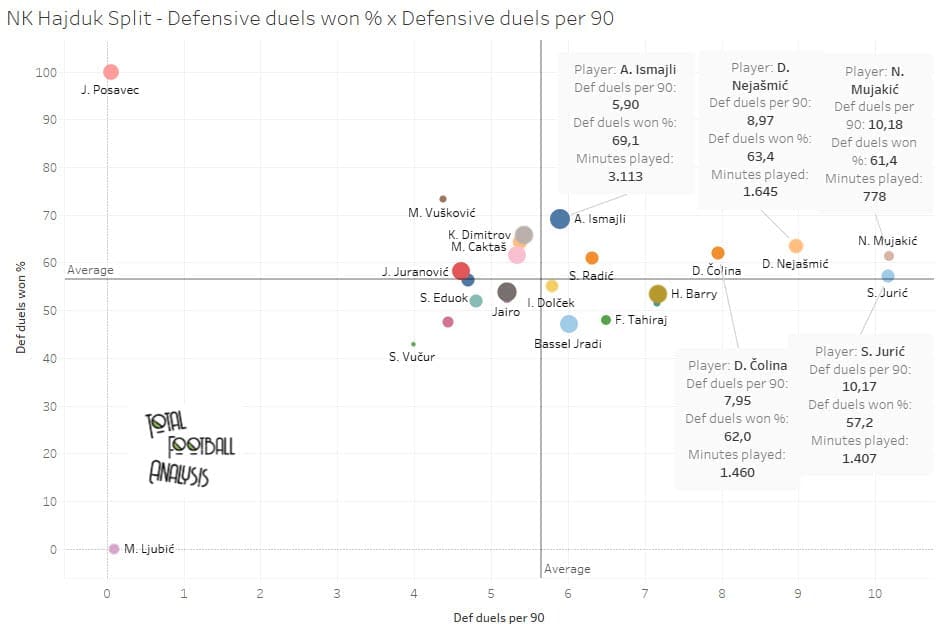
Interestingly, their loanee Nihad Mujakić and Stanko Jurić are the best in this regard, tallying 10.18 and 61.4% and 10.17 and 57.2% respectively but both with below-average game time throughout 2019/20.
However, Nejašmić (8.97 and 63.4%) and the 19-year-old David Čolina (7.95 and 62%), who joined from Ligue 1 side AS Monaco, are young and emerging talents that are already quite high in the rankings and bound to improve. Ismajli tallies the highest percentage of defensive duels won with 69.1% but doesn’t engage in them as often – 5.90 per 90 minutes.
It’s important to note that their first-choice pivot, Hamza, engages in many duels (7.17 per 90) but wins a below-average number of them (53.49%), which could be an issue in the defensive phase of Hajduk Split.
Now we’ll identify the biggest pieces in attack by measuring their goal contribution (goals + assists) and expected goal contribution (expected goals + expected assists).
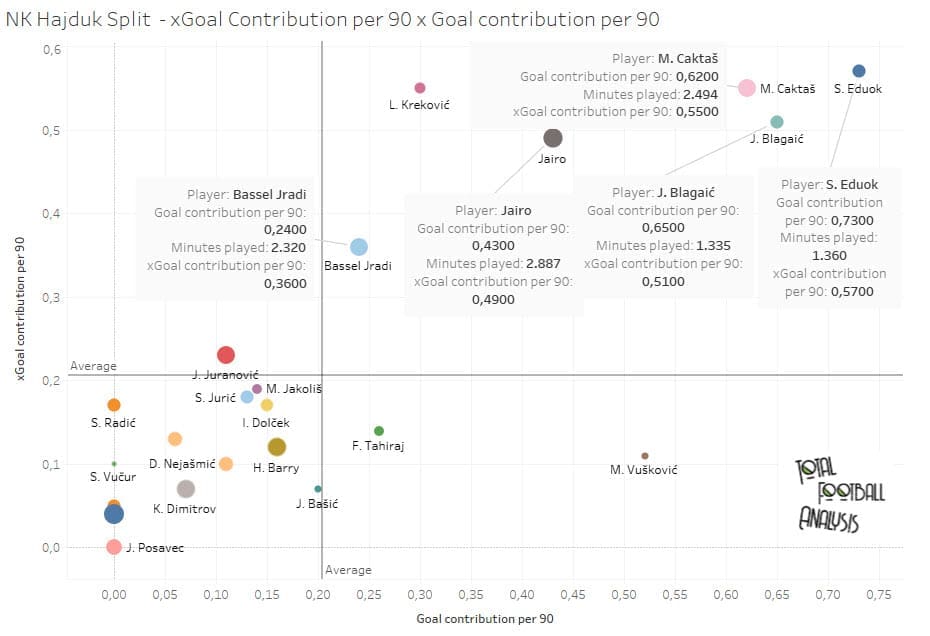
Once again, two players with a slightly below-average minute tally in 2019/20 recorded the best output so far: Samuel Emem Eduok with 0.73 goal contribution per 90 from 0.57 expected goal contribution and Jakov Blagaić with 0.65 from 0.51, both overperforming their expected values.
As far as the more regular squad members go, Caktaš is by far the most impressive with 0.62 from 0.55, and is followed by Jairo with 0.43 from 0.49 and Jradi with 0.24 from 0.36. Leon Kreković has some impressive numbers but with only 956 minutes played in 2019/20, his figures are somewhat skewed with the lack of regular game time.
Next, we’ll deal with creativity by measuring passes into danger area per 90 (passes into the final third + passes into the penalty area per 90) and key passes per 90 minutes.
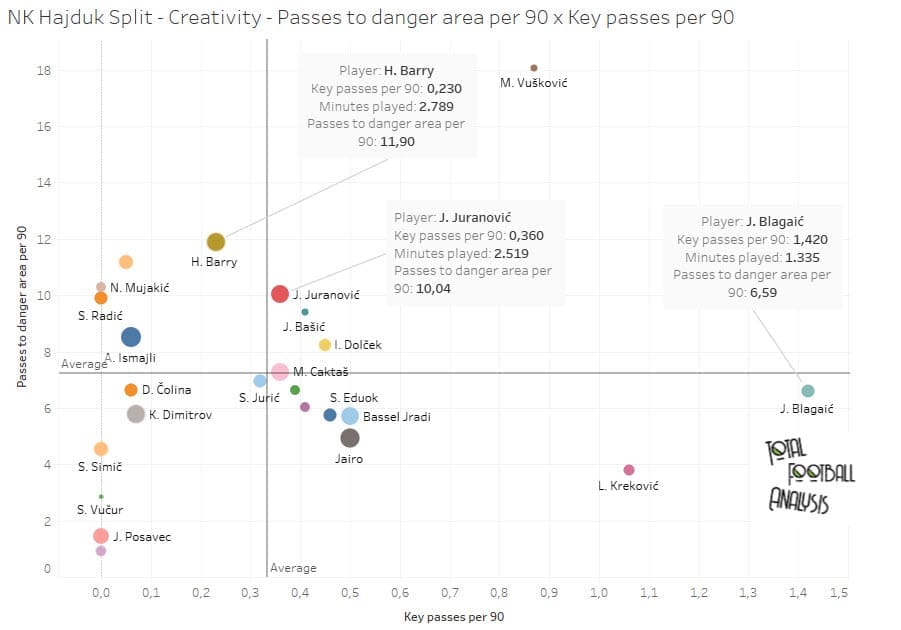
We have highlighted three players in the graph but only Blagaić tallies impressive key passes per 90 with 1.42. Other notable names in that department who also have a significant role in the squad are the attacking players like Jairo and Jradi.
Juranović is great at progressing the ball and also tallies above-average key passes with 10.04 passes into the danger area and 0.36 key passes per 90 while Hamza leads the line in the former category with 11.90 per 90 minutes.
Finally, we’ll filter the progressors in the team from the sheer volume passers-by measuring passes per 90 minutes and progressive actions per 90 minutes (progressive passes + progressive runs per 90 minutes).
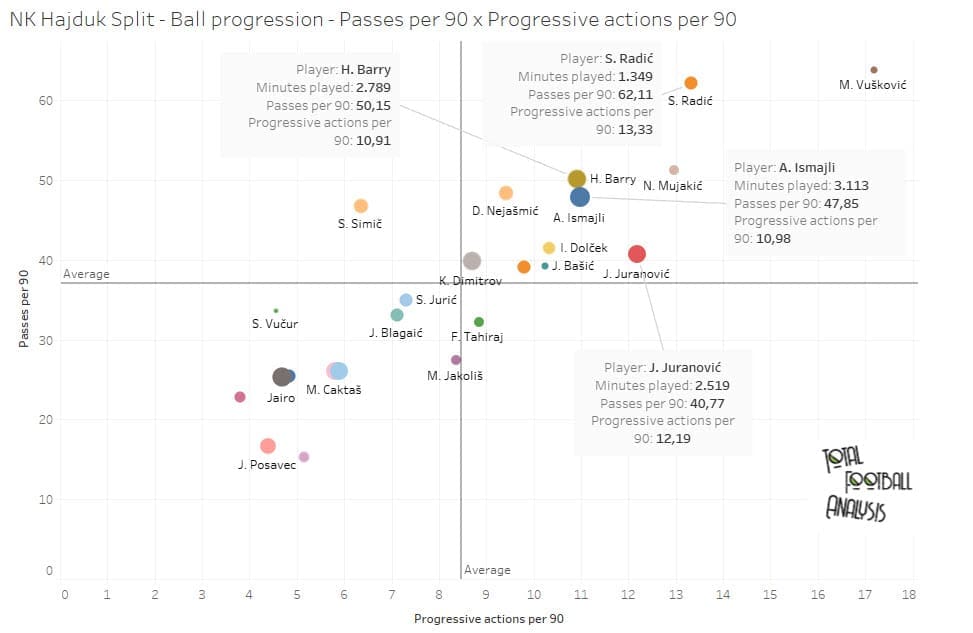
And since all three of Ismajli, Stipe Radić, and Juranović are highlighted in the graph, we can determine that Hajduk’s best progressors are indeed in the backline, confirming our initial thesis of positional football that starts from the back.
Hamza as their designated pivot is also extremely involved in the build-up and is tasked with connecting the thirds and progressing the ball further up the pitch. Of course, we should mention that they lost an incredible asset in Filip Bradarić who was transferred to Serie A.
Another problem, however, is that Hajduk Split under Igor Tudor doesn’t exactly have a gala XI and the personnel the coach likes to use varies from game to game, which affects the numbers in our data analysis.
Build-up tactics
Even though Hajduk Split have predominantly been building up with a four-man defence in the first part of the season, using the 4-2-3-1 in 24.1% of their games, things have changed drastically upon the arrival of Tudor. Now, they prefer to use three players in the back, swapping to a 3-4-1-2 with a dropping double pivot and a player between the lines and behind the forward line.
We will specifically deal with two types of build-up patterns that have to be observed under the new coach: the usage of a dynamic double pivot in front of a front three and, depending on the personnel chosen, a single pivot connecting the thirds. The structure is also highly dependable on the defensive approach of the opposition, changing when pressed and when facing a deeper, less aggressive block.
Generally, however, in a 3-4-1-2 formation, we will see two midfielders, Hamza and whoever is chosen by Tudor, position themselves right in front of the back three. Since many teams in the league will indeed press with a two-man forward line, the back three enables them numerical superiority in the first phase of attack and the pivot, whether double or single, drops for easy progression through the middle.
Hajduk, however, tend to spread the ball wide and progress through the flanks for the majority of the time. If the press is not aggressive and they can recycle the ball in the backline against a front two, they will do it and eject their wide centre-backs into open space for a progressive run. If, however, the press is more aggressive on the ball-carrier, the pivot will often drop and become the third centre-back, sending the wide defender onto the flank and pushing the wide midfielder/ wing-back even higher up the pitch, as can be seen in the graphic below.
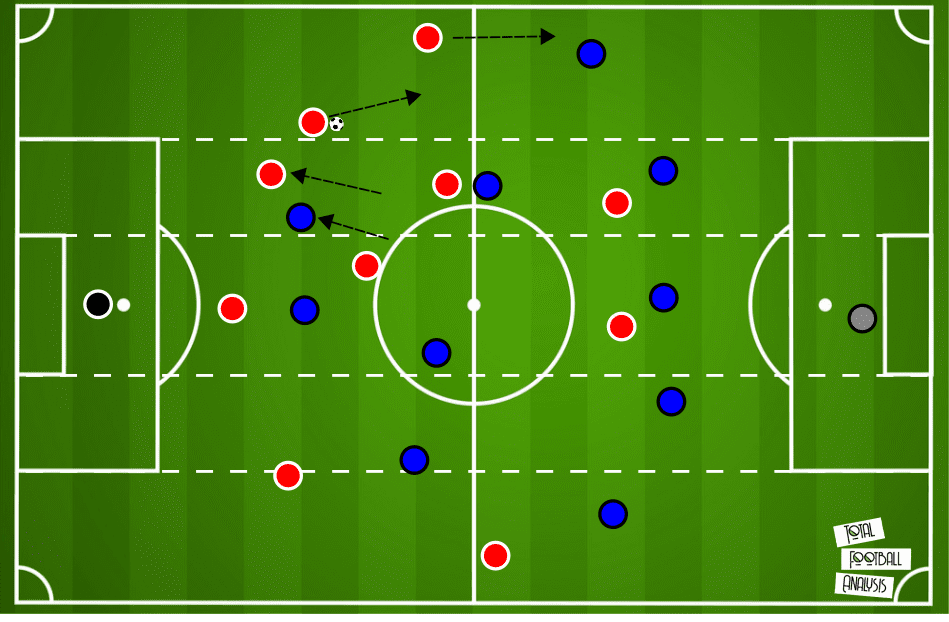
Since their options for shifting the sides are mostly covered, the pivot helps to spread the defensive line and occupy the pressing forward, sending his wide centre-back out wide where he can progress with the ball and then connect with his teammates.
We can an in-game example against Rijeka below. One of the midfielders drop into the backline, immediately getting the attention of the forward, and the wide centre-back drifts wide where he can receive the ball without a marker on him.
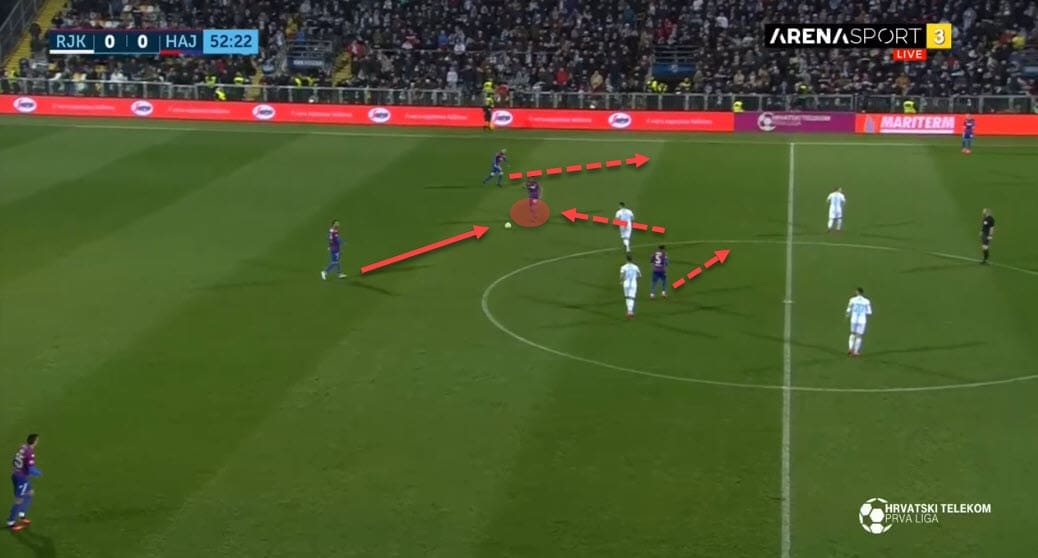
Since most of the teams will press with a front two that becomes a front three once the ball is sent wide, this ensures Hajduk will force a man from the opposition’s second line to engage or risk leaving the ball-carrier with enough space to progress. If they engage, however, space opens up for the wide midfielder/ wing-back to receive since then there is no one to apply pressure on him.
The midfielders, however, are quite dynamic and one’s movement affects the other. If only one is necessary to drop, the other will drift into space so the ball can be progressed immediately after This can be seen in the example below as Hajduk Split beat the press with Hamza dropping and connecting with his teammate higher up the pitch.
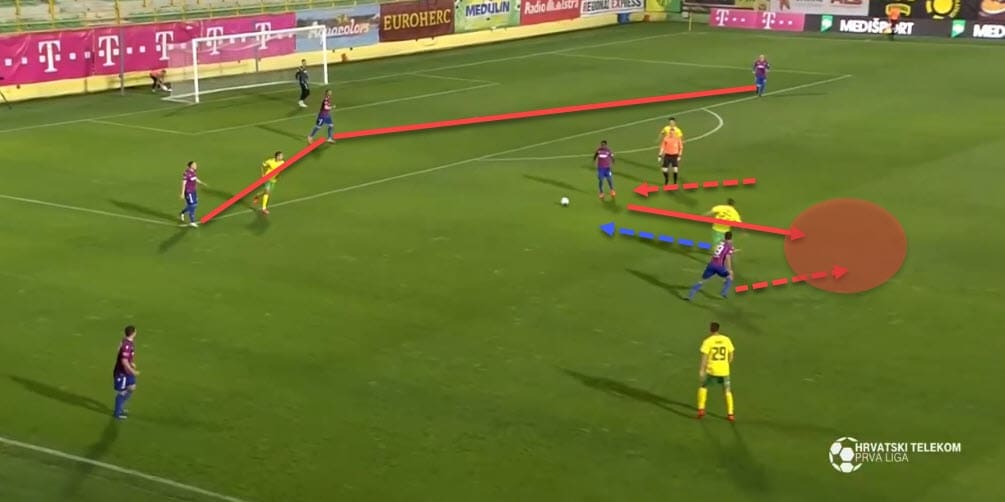
Another example can be seen below, once again one man dropping to receive while the other is occupying the marker so that the ball can be progressed with ease. This is against a deeper block and the midfielder can then turn and spread the ball wide or run towards the final third.
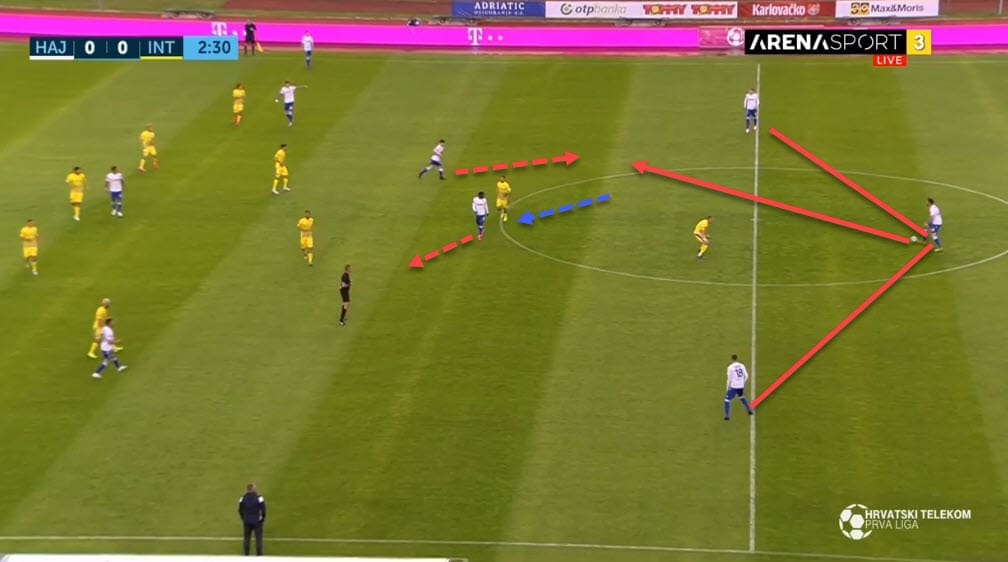
Finally, we’ll observe a situation in which Hajduk Split struggled to cleanly progress up the pitch against the side that has pressed them successfully, NK Rijeka. Simon Rožman’s team had a very structured way of pressing the Split squad and would usually force their backline into long balls.
Notice below how the white shirts have both pivots closely marked and the wide players are covering the entrance into half-space, meaning Hajduk can’t eject their centre-backs into space after recycling the ball in the backline.
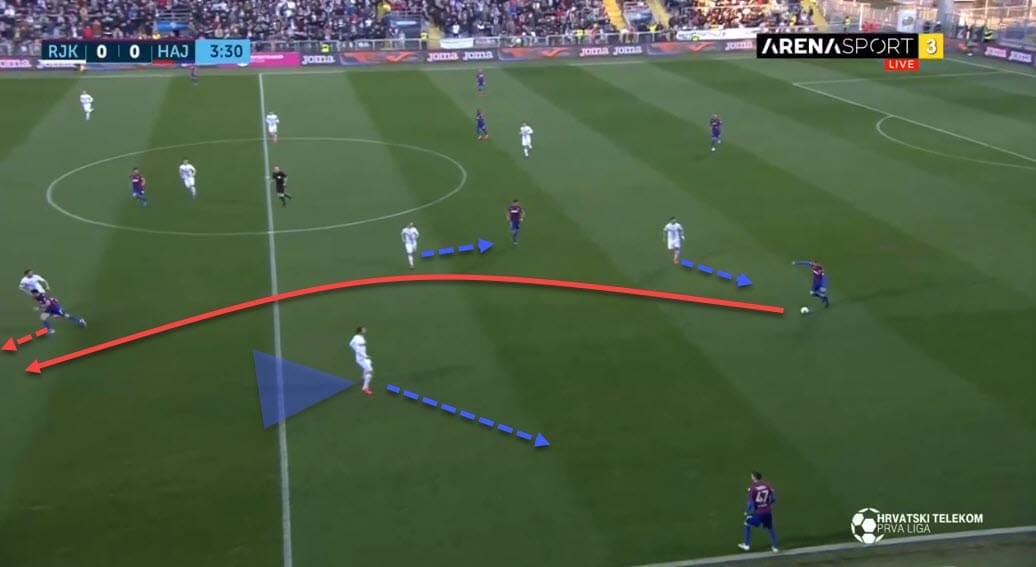
Of course, the ball can move forward towards the wing-back but he can also be engaged immediately and doesn’t have a clear channel for progression. So Hajduk opt for a long ball over the top and the attack breaks down soon after. And that’s exactly what kept happening time and time again throughout the game.
When deploying the long balls, they will usually try and either find a forward bursting into space or dropping deeper to serve as a target man who can lay the ball off to the midfield. We can see an example of that below as they successfully find a channel to progress through a lofted ball.
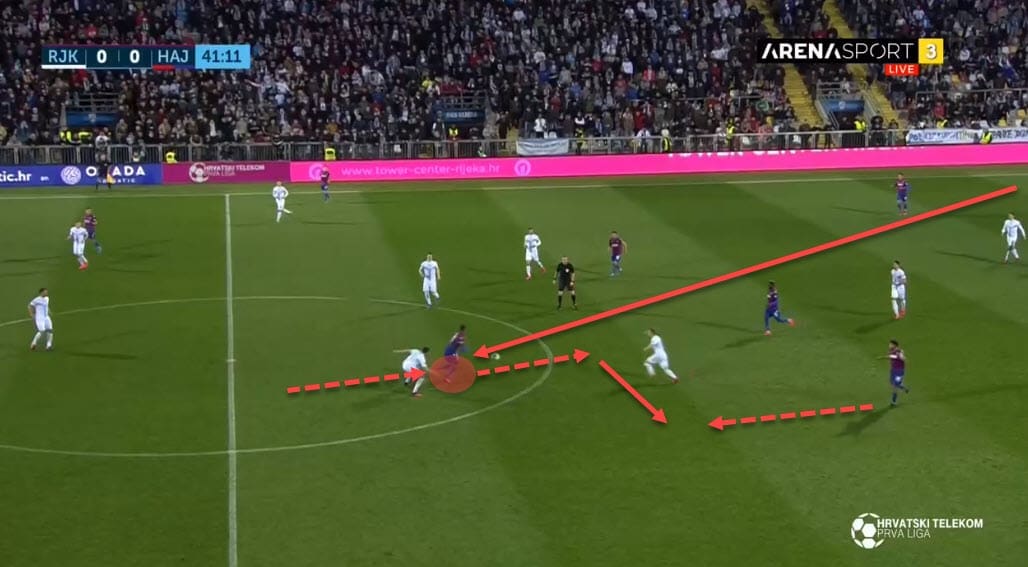
However, as they drop their forward from his usual position and the midfielder eventually gets to the ball and starts to drift wide, Hajduk realise that they have sacrificed all of their height just to escape the press and Rijeka can quickly recover and plug the holes, forcing the Split team back since they have no outlets to exploit in the final third.
Final third movement
Hajduk Split are certainly one of the most dangerous teams in front of the goal and they prove it with 48 goals scored in 2019/20 so far, only behind Dinamo Zagreb who are on 56. They are also a highly aggressive team, tallying the second-most number of 1 v 1s and dribblings, third-most touches in the box, second-most corners and fourth-most shots in the league.
That dynamic nature and good movement inside the area have awarded them a league-high 10 penalties this season, nine of which have been converted. But how exactly do they create those dangerous situations in front of goal?
We’ve already mentioned that the first phase of Hajduk Split’s attack starts with the backline. They are responsible for getting the ball into advanced areas and, with the help of the pivot(s), they connect the thirds and progress higher up the pitch using the tactics we covered in the first section of our tactical analysis.
Below, you can see a graphic depicting one of the common patterns in the final third. The ball is usually moved forward by one of the wide defenders who are ejected into space, which pushes the wing-back or a wide midfielder higher. At the same time, one of the forwards will drop into the half-space to offer an additional channel and, depending on whether a midfielder can join from the central area, Hajduk can create either a diamond or a triangle in the wide area.
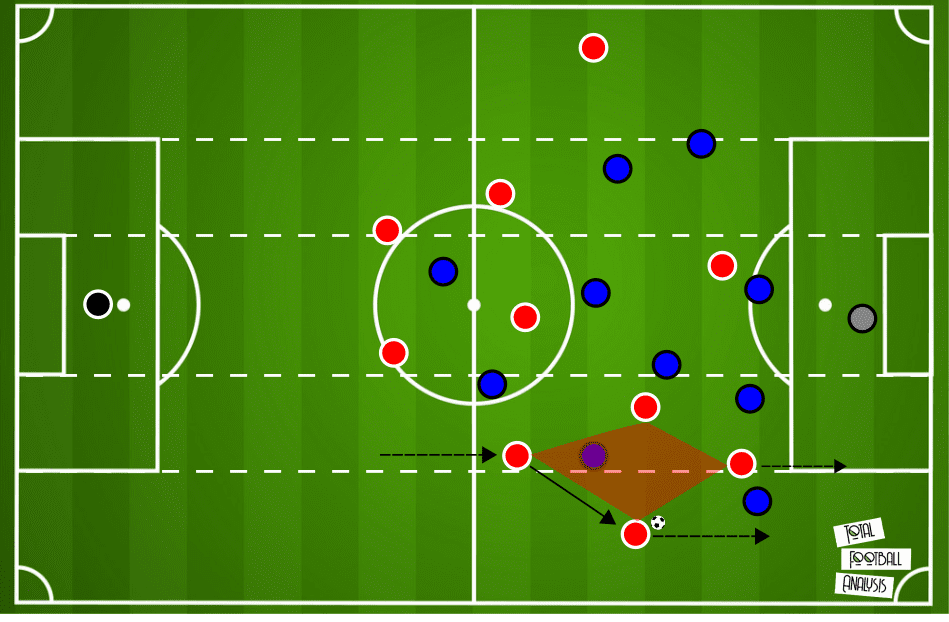
We can see a rather similar action in the image below as the ball is progressed by one of the defenders who could escape the press, burst into space and then connect with their teammates higher up the pitch.
In this case, the double pivot stays deeper while Caktaš moves closer to complete the diamond alongside the wing-back and the forward dropping into the half-space.
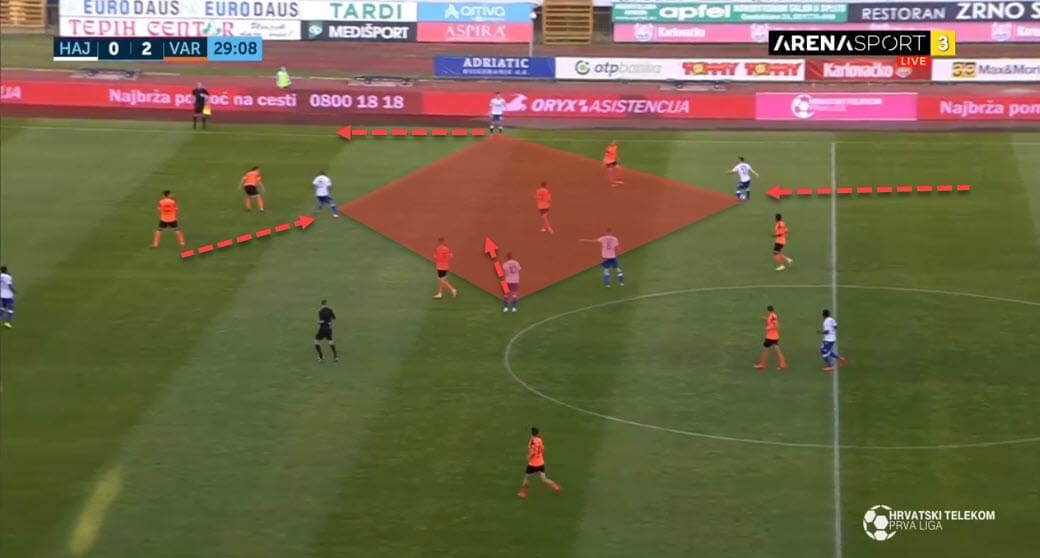
This type of movement opens multiple channels for them to exploit, both behind the defensive line and between the thirds in pockets of space that are often occupied by the forwards. But it also enables them to overload the wide defender and drag the centre-back out of his position.
We can observe a similar pattern down in the example below in a recent game against Istra.
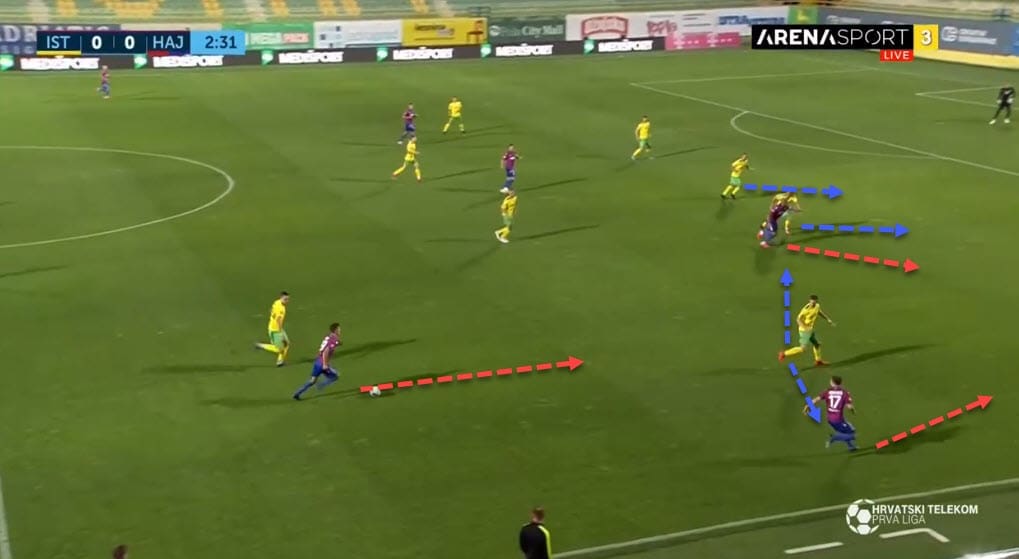
Once again, the progression starts from the backline, the wing-back is pushed higher up the pitch and the forward drops into half-space. This makes a dilemma for the wide defender as he has two players to mark and also moves the centre-back out of the defensive shape, creating space centrally as well.
Players like Jairo, Jradi, Caktaš, or Blagaić are extremely potent in creating for the team, either through their movement or passing. Caktaš is likely the most important attacking piece both according to his overall goal contribution and expected goal contribution while no one in the squad comes close to Blagaić’s key passing per 90 minutes albeit with a small caveat of less game time.
Exploiting the space between the lines is an important weapon in their arsenal and usually, we will find either Caktaš or Jairo trying to occupy those positions – one by progressing through central channels or the half-spaces and the other by drifting wider.
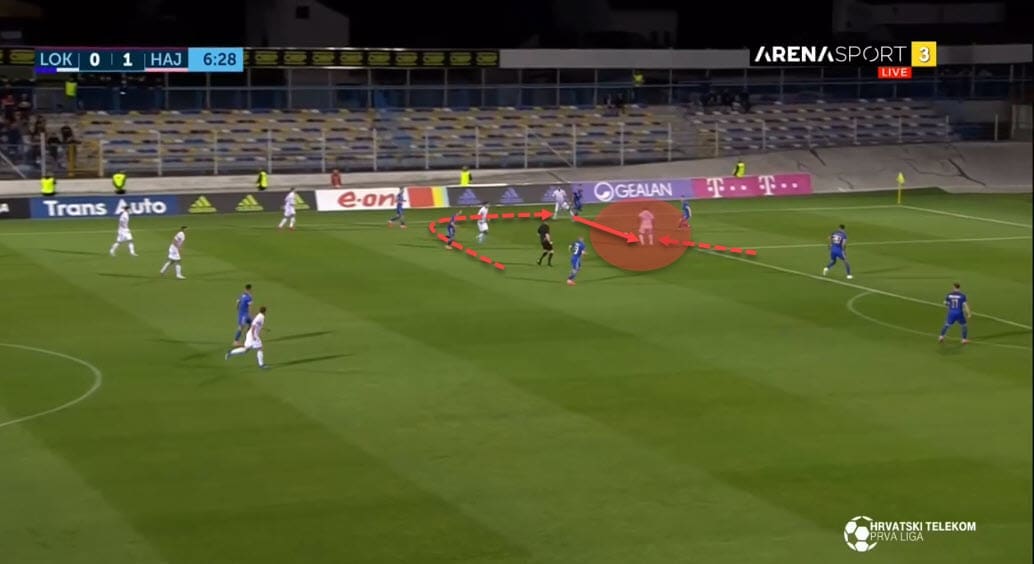
In the above example, Caktaš wins the ball out wide and starts to progress up the pitch and Jairo immediately drops into the half-space, positioning himself between the lines to receive the pass from his teammate. From that position, he has the technical ability to force something on his own or turn and deploy a pass to someone else joining the attack.
A lot of their success in the final third is also conditioned by a high volume of loose ball duels and duels in general with Hajduk Split having multiple players near the top in those metrics. Combined with the reliance on individual skill, sometimes they create danger through flashes of brilliance rather than sustained and structural outplaying of the opposition.
Defensive & transitional phase
We have already seen that Hajduk Split under Igor Tudor are one of the most aggressive teams in the defensive phase in the whole league. Overall, they prefer to have the ball at their feet and control possession, but high recoveries and turnovers are also a big part of their tactics.
In general, they make more recoveries in the final third (13%) than most of the other teams with only Dinamo (16%) and Osijek (15%) tallying more. They are also second in the league when it comes to PPDA (7.50) values and make the fifth-most fouls in the league (13.04 per 90). This can immediately give us a relatively clear outlook on their aggressive defensive style but what are some of the most common structures they use?
Hajduk often adapt to the opposition, meaning their defensive shape will differ depending on the build-up scheme used by the opponent. Generally, however, we can see them in a 4-4-2 mid-block, often used against teams that play with four in the back, or a dynamic 5-2-3 that transforms into a 4-3-3 or even a 5-3-2- into a 4-4-2 that can tackle a three-man backline.
Let’s observe a common structure used when pressing a three-man defence that tries to build-up from the back below. Hajduk approach with three forwards, each having a task to mark his counterpart.
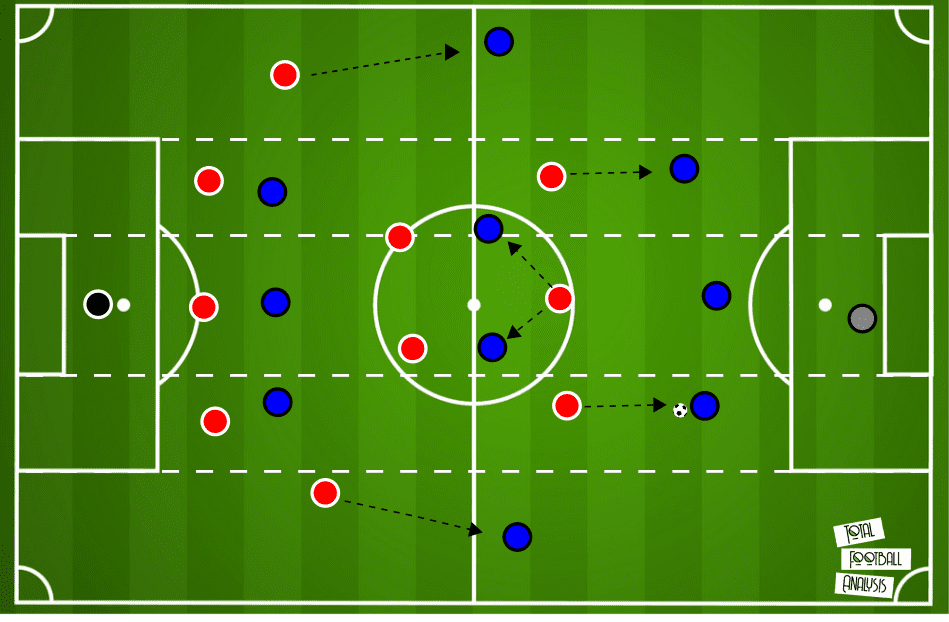
The central defender is usually not engaged but as soon as the ball goes to the wide centre-backs, the wingers will engage the ball-carrier. In this instance, the central player will use cover-shadow to mark the pivot or stay tightly beside him if he tries to offer himself and run into space.
Similarly, if the ball is then progressed to the full-backs, it’s usually the wide midfielder’s or the full-back’s task to cover him, depending on the overall shape. Hajduk are not afraid to man-mark the pivots if the opposition is using one (or two) so this will affect which player steps out to put pressure on the wide man.
We can see an in-game example of exactly that structure which was used in their defeat to Lokomotiva Zagreb. A three-man press against a three-man backline, central attacker sticking to the pivot while the wide forward engages the wide ball-carrier once he has received the ball.
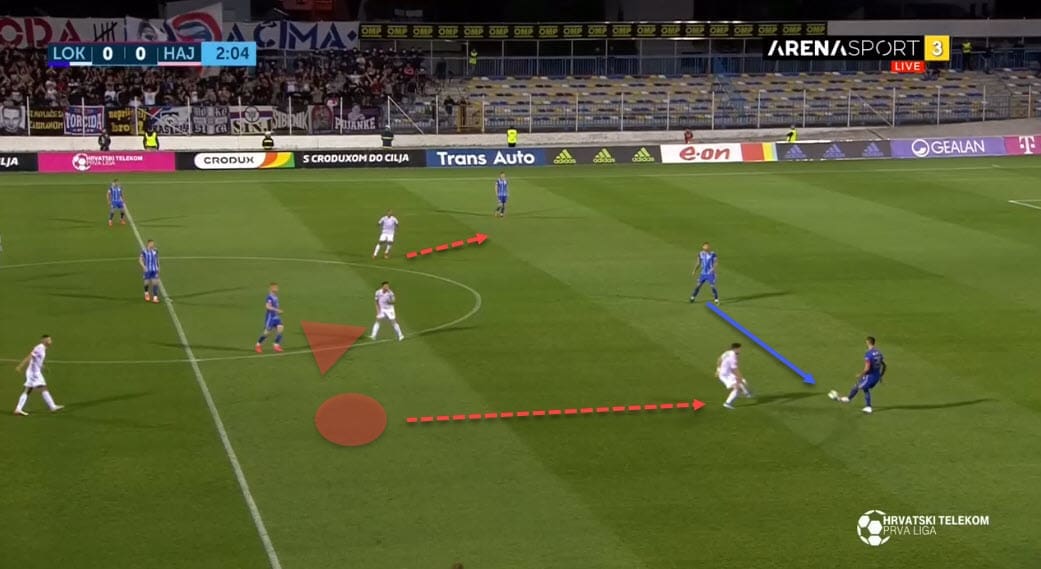
And usually, it will be a mid-block that expands further up the pitch once the opportunity arises. However, Hajduk tend to suffer in their defensive setup in the last 15 minutes of both halves, which is when they concede the most chances.
While this tactical analysis won’t strictly deal with identifying flaws in their system, we can mention their tendency to leave the pivot free to receive the ball, which leads to easier progression for the opposition.
This trend has happened in multiple games, most notably in defeats to both Lokomotiva and Rijeka, and often in that particular time-span we’ve mentioned earlier, suggesting a loss in concentration and/ or stamina as they approach the end of the half.
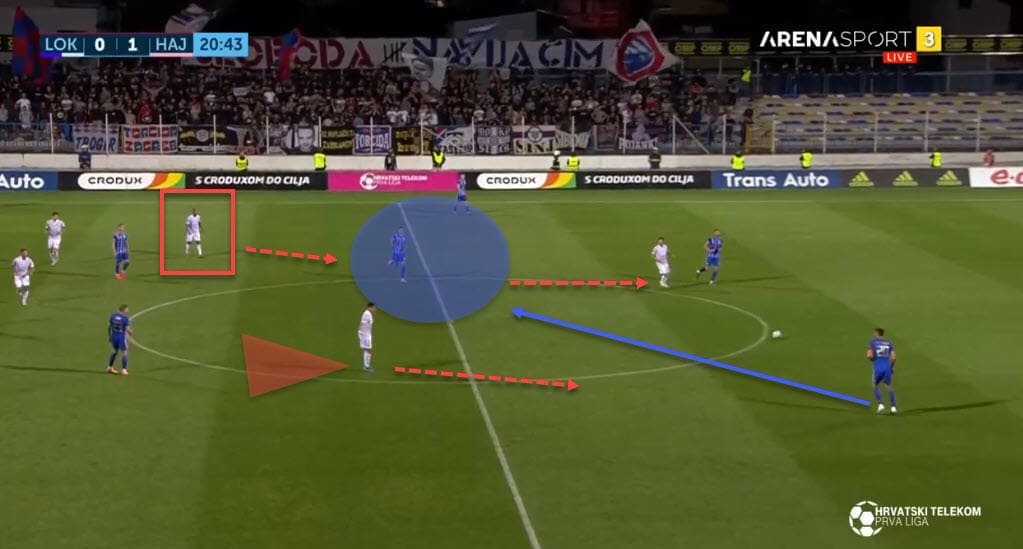
The above example depicts the central player, usually Caktaš, moving up to press the ball-carrier while none of the wide players take the pivot who was in his cover-shadow. In the example, it’s Jairo who is late to react but the pressing sequence is perplexing because it deviates from their usual structure of only pressing the wide man and then engaging centrally through a curved run if there’s an option to cut the channel and force the opposition into mistakes.
If the first line of the press is beaten, they usually retreat to a deeper and compact 4-4-2 structure. If, however, they can force the opposition further up the pitch and towards the goalkeeper, they will push up with numbers, utilising a heavy man-marking approach to cover all the options and ideally force a clearance from the goalie.
We can see an example of that below against Varaždin.
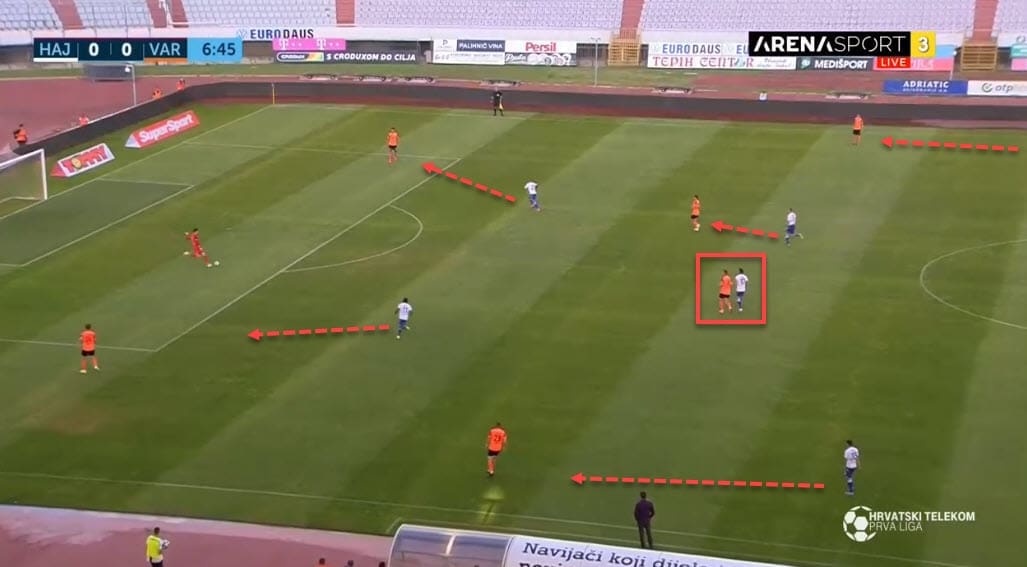
Even though they can be highly aggressive in their pressing, they don’t counter-press at all times. In fact, in most cases, the counter-press will only be activated by the nearest player to the ball or the player who lost it in the first place.
When it comes to rest defence, usually two midfielders tend to stay behind in case the opposition instigates a quick turnover. We can see below that Hajduk’s pivot staying behind the ball in attack and then ensuring the ball is recovered and the attack can continue shortly after losing possession.
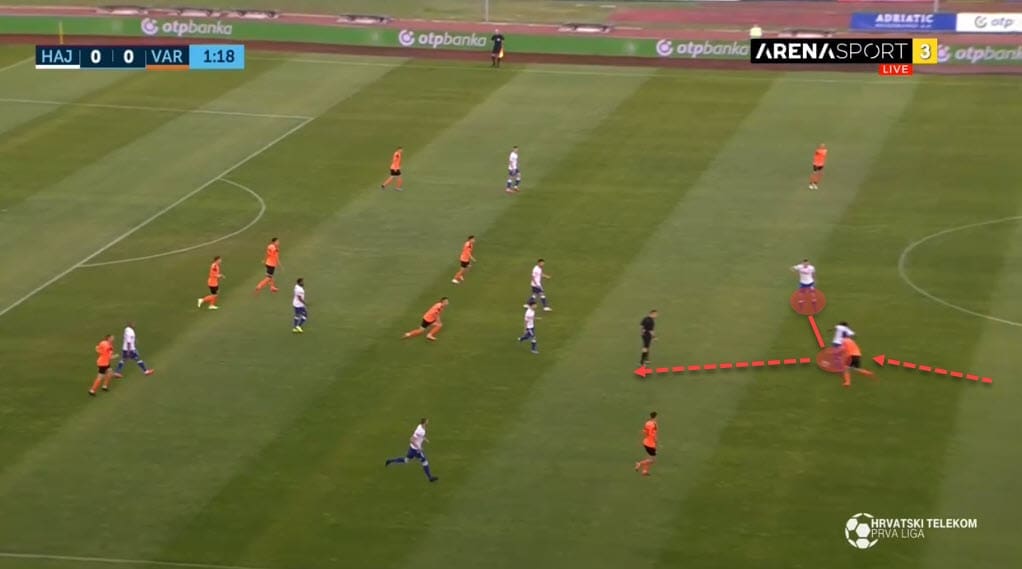
Finally, we’ll take a look at their transitions, which are also a big part of their arsenal. We have already established that Hajduk recover the ball higher up the pitch more often than most of their 1. HNL opposition but the same principles of finding players between the lines and in free pockets of space apply here, just like in the analysis of the attacking movement.
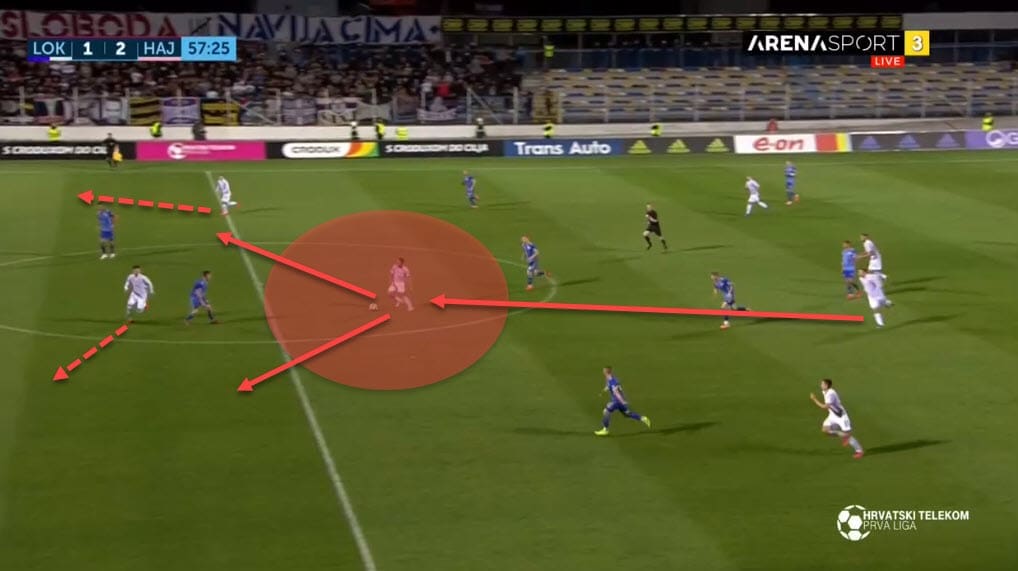
The above example shows us Caktaš receiving the ball between the lines and in a free pocket of space during a successful transition. Once again, the familiar structure persists – one player between the lines to connect the thirds and the other(s) making runs to open passing channels to exploit.
Final remarks
Igor Tudor has managed to instil some structure and clear tactical approach into Hajduk Split but the team seems to be struggling as of late. Selection issues, defensive trouble as well as the lack of a clear offensive plan at times combined with the off-the-pitch situations have all impacted their 2019/20 season.
However, there have been some good signs from the Whites as well and we’ll have to wait and see what the future holds for them. In the meantime, we will analyse one of their young prospects, Mario Vušković, and then pay their eternal rivals Dinamo Zagreb a visit as well.
Stay tuned.





Comments